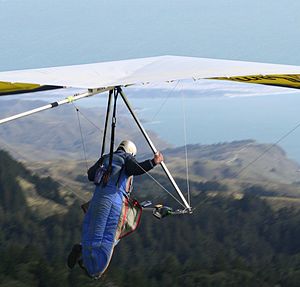
Unpowered aircraft
About this schools Wikipedia selection
This content from Wikipedia has been selected by SOS Children for suitability in schools around the world. Sponsor a child to make a real difference.
Unpowered aircraft are a group of aerial vehicles that can fly without onboard propulsion. They can be classified as gliders, balloons and kites. In this instance, 'flight' means a trajectory that is not merely a vertical descent such as a parachute. In the case of kites, the flight is obtained by tethering to a fixed or moving object, perhaps another kite. In the case of balloons, the flight is free but there is little directional control. The remainder of this group are the heavier-than-air craft such as gliders, hang gliders. and paragliders that have complete directional control and so can fly freely.
History
- For history of gliders, see Glider aircraft
- For history of glider/sailplanes, see Glider (sailplane)
- For history of hang gliders, see History of hang gliding
- For history of paragliders, see Paragliding
- For history of balloons, see Balloon
- For history of kites, see Kite
- For history of airborne wind energy aircraft, see High altitude wind power
The first manned aircraft were kites, balloons and gliders. Kites are recorded in ancient Chinese history as being used for lifting men. Unmanned hot air balloons are also recorded in Chinese history. However the first free flight (i.e., untethered) by manned craft was by balloon built by the brothers Joseph-Michel and Jacques-Etienne Montgolfier in Annonay, France in 1783. The first practical, controllable glider was designed and built by the British scientist and pioneer George Cayley who many recognise as the first aeronautical engineer. It flew in 1849. Thereafter gliders were used for aerodynamic research, until their sporting use was developed in the 1920s.
Glider aircraft
Sailplanes, hang gliders and paragliders can gain some initial energy from a launch process, but can then gain additional potential energy from rising air such as thermals and ridge lift. The launch may be by pulling the aircraft into the air with a tow-line, with a ground-based winch or vehicle, or with a powered "tug" aircraft. For foot-launched aircraft, there is also the option of merely stepping off a high location.
For glider aircraft to generate lift, they must maintain sufficient forward air speed. This is achieved by a gradual descent, though if the air is rising faster than the aircraft is descending, it will also ascend. Today, the majority of the use of all types of glider aircraft is recreational.
In the past unpowered aircraft have been used for military applications.
Balloons
Balloons drift with the wind, though normally the pilot can control the altitude either by heating the air or by releasing ballast, giving some directional control (since the wind direction changes with altitude). A tethered wing-shaped balloon has been tested which has greater directional control. Today, the majority of the use of manned balloons is recreational, whereas unmanned balloons are widely used for meteorological measurement.
Kites
Kites are aircraft that are tethered to some other object (fixed or mobile) or other means that maintain tension in the kite line; and rely on virtual or real wind blowing over and under them to generate lift and drag. Kytoons are balloon kites that are shaped and tethered to obtain kiting deflections, and can be lighter-than-air, neutrally buoyant, or heavier-than air. Kites have been developed for commercial applications using kite control systems, including the airborne wind energy systems of high altitude wind power.

